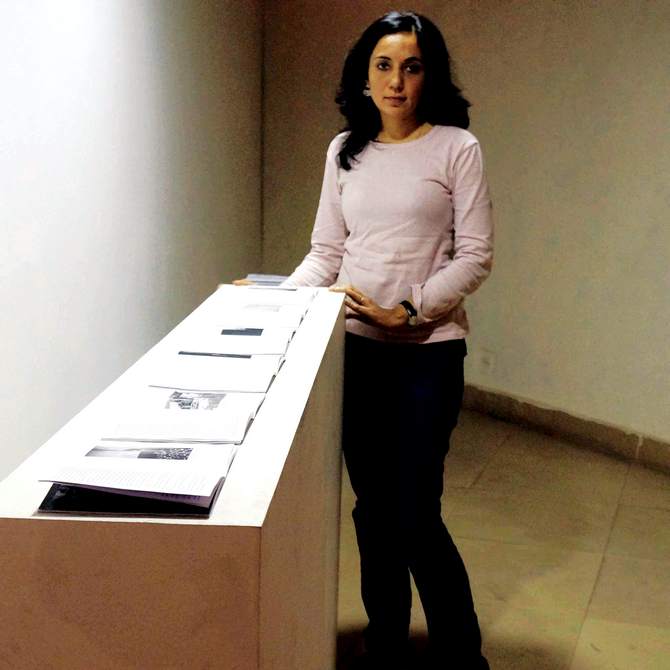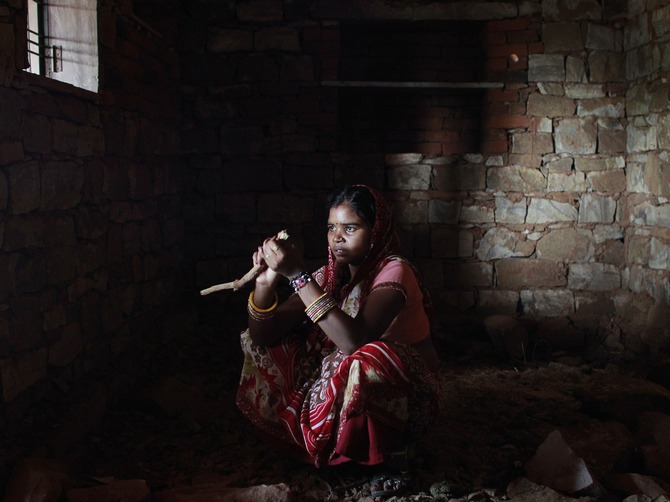Photographs: Courtesy Shuddhabrata Sengupta Aseem Chhabra
Seated in a Manhattan gallery, photographer Gauri Gill takes Aseem Chhabra through the decade-long journey behind Balika Mela and Jannat
Gauri Gill has spent many years visiting and staying in Rajasthan. Often she would stay in the guesthouse of a non-governmental organisation called Urmul Setu Sansthan.
And at one point the Delhi-based photographer thought about working on a photo essay about rural education, especially related to young girls. That was around 1999.
"And then I sort of stumbled into this other world," Gill recently said in New York City.
A graduate of New Delhi's College of Art and New York City's Parson School of Design, Gill also has an MFA from Stanford University.
She was in New York, seated in the Thomas Erben Gallery in Manhattan's Chelsea section. And she was surrounded by her photographs -- part of her show entitled Balika Mela and Jannat.
It is a rare opportunity for an Indian photographer to show her works in Manhattan's highly competitive art world.
In one village in Rajasthan, by chance, Gill met a Muslim woman Ismat Bai, a single mother of two young girls -- Jannat and Hurran.
"She caught hold of me and fired me, gave me a lecture and said 'Go and tell Sonia Gandhi, we don't have water, we don't have electricity,'" Gill said.
"I gave her my address and now 14 years later she is my friend and she still writes to me."
Time went on and Gill started making more frequent trips to Rajasthan.
She saw Jannnt and Hurran grow up. She described Ismat as a lioness protecting her daughters from the world.
It became a decade-long journey.
There was no agenda, and she now has an archive of more than 40,000 negatives.
There are various stories in that archive. One of those is that of Ismat and her family, whom Gill kept photographing, every time she visited.
Then in 2009 when she was editing for another show she realised that she had a lot of pictures of Ismat and her family.
Jannat had died at the age of 23 and Gill finally decided to share her pictures in a show in 2012.
Initially she was reluctant to show the photographs.
"These are fragile relationships and I was unsure what will happen to them," she said. "I felt a big responsibility to what I was doing. And I wanted to do justice to my friends, to honor their experience -- and our own experience together."
Jannat is a moving set of photos of a family life, reflection of rural poverty in India and a collection of loving letters that Ismat wrote to Gill. As viewers we feel privileged that Ismat allowed Gill to share them with us.
Gill has lost count of the number of trips she has taken to Rajasthan in the last 15 years or how many times she has met up with Ismat.
The longest she stayed there was for a year, at times informally volunteering with some of the NGOs -- as an independent artist, she is clear she never worked for any of them -- and always taking photographs.
During one of her longer stays in 2003, Gill was invited to Balika Mela -- a girls-only fair in Rajasthan. She set up a tent based on local studios and took pictures of young girls.
Notes from the desert: What it means to be a girl in Rajasthan
Image: Picture used here for representational purposes onlyPhotographs: Danish Siddiqui/Reuters
The series of portraits and group photos she took appear in a book also titled Balika Mela (2012).
Some of the Balika Mela pictures now hang in the Thomas Erben Gallery.
Surprisingly, in all of the pictures, the girls are not smiling.
In between the photo shoots, the girls were playful, joking among themselves.
But Gill never told the girls to pose in any particular manner.
"It has to do with how you present yourself," she said.
"And I think they don't have the notion that they have to smile for the camera. I think that is more our thing perhaps, a notion we have. I didn't ask them to do anything in particular."
In some pictures the girls are wearing paper hats or making hand gestures.
It was all done spontaneously.
Gill's only commitment was that each girl would get a print of her picture.
Then in 2010 she went to the mela again, just to show her pictures.
Seven years later some of the girls were married or had moved on.
On popular request Gill took some more pictures, many of different girls, some related to the earlier girls or from the same villages, although this time in color.
"I was bored working in black and white since I had already done that, and I didn't want to repeat myself," she said.
"Plus I had colour film. Then I realised that in color the photographs become much more about the fashion and the materiality."
During this time Gill has done some more amazing work, including photographing the survivors of the 1984 anti-Sikh riots in Delhi.
In 2005 she was commissioned to work on the pictures by Tehelka magazine.
Later, in 2009, on the 25th anniversary of the riots Outlook magazine asked her to take additional pictures.
"The atmosphere is so depressing," she said of her trips to the colonies in Delhi where the victims of the riots were housed.
"You see disaffected young men and widows. These colonies are in the heart of Delhi, but it is another world. It is like a border you cross."
The conversation about the post-riots situation has continued through her photographs.
Last year, to mark a photo festival on 'the city' in Mumbai, Gill gave a set of the riot-related images to her friends and asked them to write comments or their reactions to the photographs.
"People wrote such moving texts," she said.
So she decided to place all of those images with the comments in a pamphlet that has appeared on the Net, for free distribution.
It may surprise some to know that Gill still continues to shoot photographs on film.
There is always the risk since films are now in short supply. But she just recently bought her first digital camera.
"Partly it has to do with the fact that I don't want to see what I am shooting when I am doing it," she said.
"I want to be present in the moment. So, I skip the whole process of shooting and then obsessively checking. I also like the way film looks, its inherent quality. But for the future, I can't say."



Comment
article